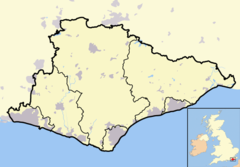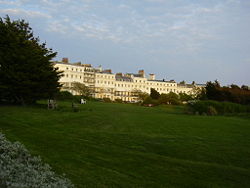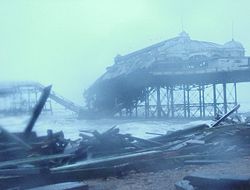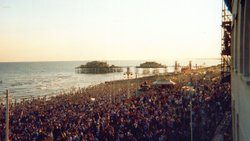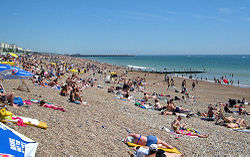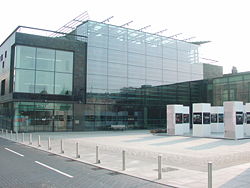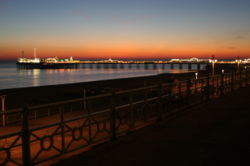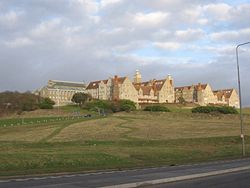Brighton
2008/9 Schools Wikipedia Selection. Related subjects: British Cities; Great Britain
|
||||||||||||||||||||||||||||||||||||||||
|
|
||||||||||||||||||||||||||||||||||||||||
|
|
||||||||||||||||||||||||||||||||||||||||
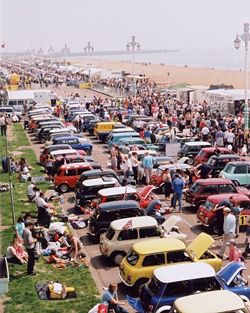
Seafront display of Minis after a London to Brighton drive
|
||||||||||||||||||||||||||||||||||||||||
Brighton ( pronunciation ) is on the south coast of England, and with its neighbour Hove forms the city of Brighton and Hove.
The ancient settlement of Brighthelmston dates from before the Domesday Book (1086), but it emerged as a health resort during the 18th century and became a destination for day-trippers after the arrival of the railway in 1841. Brighton experienced rapid population growth reaching a peak of over 160,000 by 1961. Modern Brighton forms part of a conurbation stretching along the coast, with a population of around 480,000.
Brighton welcomes 8 million tourists a year with its hotels, restaurants, shops and entertainment facilities, which additionally serve a substantial business conference industry. Brighton and Hove is also an educational centre with two universities, a medical school and many English language schools.
History
In the Domesday Book, Brighton was called Bristelmestune and a rent of 4,000 herring was established. In June 1514 Brighthelmstone was burnt to the ground by French raiders during a war between England and France. Only part of the St. Nicholas Church and the street pattern of what is now The Lanes survived. The first drawing of Brighthelmstone was made in 1545 and depicts what is believed to be the raid of 1514. During the 1740s and 1750s, Dr Richard Russell of Lewes began prescribing seawater at Brighton. By 1780, development of the Georgian terraces had started and the fishing village became the fashionable resort of Brighton. Growth of the town was further encouraged by the patronage of the Prince Regent (later King George IV) after his first visit in 1783. He spent much of his leisure time in the town and constructed Royal Pavilion during the early part of his Regency.
The arrival of the railway in 1841 brought Brighton within the reach of day-trippers from London and population growth from around 7,000 in 1801 to over 120,000 by 1901. The Victorian era saw the building of many landmarks including the Grand Hotel (1864), the West Pier (1866) and the Palace Pier (1899).
After boundary changes between 1873 and 1952, the land area of Brighton increased from 1,640 acres (7 km²) in 1854 to 14,347 acres (58 km²) in 1952. New housing estates were established in the acquired areas including Moulsecoomb, Bevendean, Coldean and Whitehawk. The major expansion of 1928 also incorporated the villages of Patcham, Ovingdean and Rottingdean, and much council housing was built in parts of Woodingdean after the Second World War.
More recently, gentrification of much of Brighton has seen a return of the fashionable image which characterised the growth of the Regency period. Recent housing in the North Laine, for instance, have been kept in keeping with the area.
In 1997 Brighton and Hove were joined to form the unitary authority of Brighton and Hove, which was granted city status by Queen Elizabeth II as part of the millennium celebrations in 2000.
Landmarks
The Royal Pavilion is a former Royal palace built as home for the Prince Regent during the early 1800s and is notable for Indian architecture and Oriental interior design. The building and grounds were purchased by the town in 1849 for £53,000.
Brighton Pier (originally and in full "The Brighton Marine Palace and Pier", and for long known as the Palace Pier) opened in 1899. It features a funfair, restaurants and arcade halls. The funfair has been criticised for its prices, with rides costing up to £8. Brightonians refer to it as Palace Pier in protest at the commercialisation.
West Pier was built in 1866 and has been closed since 1975 awaiting renovation, which faces continual set backs, in part because the owners of the Palace Pier, the Noble Organisation, have opposed plans. The West Pier is one of only two Grade I listed piers in the United Kingdom, but suffered two fires in 2003. Plans for a new landmark in its place – the i360, a 183m (600 ft) observation tower designed by London Eye architects Marks Barfield – were announced in June 2006. Plans were approved by the council on 11 October 2006.
Created in 1883, Volk's Electric Railway runs along the inland edge of the beach from Brighton Pier to Black Rock. It is the world's oldest operating electric railway.
The 11th century St. Nicholas Church is the oldest building in Brighton, commonly known as "the mother church". Other notable churches include St. Bartholomew's, and the Church of St. Peter, in the heart of Brighton on an island between the main roads to London and Lewes.
Beaches
The seafront has bars, restaurants, nightclubs and amusement arcades, principally between the piers. Being less than an hour from London by train has made the city a popular destination. Brighton beach has a nudist area (south of the easterly part of Kemptown). Brighton's beach has been awarded a blue flag.
Since the 1978 demolition of the open-air lido at Black Rock, the most easterly part of Brighton's seafront, the area has been developed and now features one of Europe's largest marinas. However, the site of the pool itself remains empty except for a skate park and graffiti wall, and further development is planned including a high-rise hotel which has aroused debate, mirroring proposals for the King Alfred leisure centre in Hove. In addition, part of the eastern side of the beach has been redeveloped into a sports complex, which has courts for anything from volleyball to ultimate Frisbee, opened to the public in March 2007.
Culture
Night-life and popular music
Brighton is associated with popular music artists — for a list, see night-life and popular music of Brighton and Hove. There are 400 pubs and many nightclubs. There are also live music venues including the Brighton Centre and the Brighton Dome. There are gigs every night. Queen's song Brighton Rock is centred on Brighton.
One of the most prominent musical events has been the " Big Beach Boutique II" of July 13, 2002, where 250,000 attended on the beachfront and watched Fatboy Slim.
Public events
Brighton hosts conferences including those held by political parties, often around the Brighton Centre, Grand Hotel and Metropole hotel. A range of sport and leisure clubs, in particular cycling and motoring clubs, hold London to Brighton events, culminating in a display on Madeira Drive, which is closed to traffic for this purpose on many Sundays throughout summer
Festivals
Each May the city hosts Brighton Festival, England's largest arts festival. This includes processions such as the Children's Parade, outdoor spectaculars often involving pyrotechnics, and theatre, music and visual arts in venues throughout the city, some brought into this use exclusively for the festival. The earliest feature of the festival, "Open Houses", are homes of artists and craftspeople, opened to the public as galleries and usually selling the work of the inhabitant.
Brighton Festival Fringe runs alongside Brighton Festival, and has grown to the second largest fringe festival in the world.. Together with the street performers from Brighton Festival's "Streets of Brighton" events, and the Royal Mile-esque outdoor performances that make up "Fringe City", outdoor spectacles and events more than double during May.
Other festivals include The Great Escape in May, featuring three nights of bands across the city; the Soundwaves Festival in June, which shows classical music composed in the 21st century, and involves both amateur and professional performers; Brighton Live which each September stages a week of free gigs in pubs to show local bands; and Brighton Pride (see Lesbian, gay, bisexual and transgender community, below).
On 1 September 2007, competitors from the United Kingdom, United States, Germany and other countries convened for the World Beard and Moustache Championship . Hosted by The Handlebar Club, categories include Dali moustache, goatee and full beard freestyle. Additionally, Brighton is permanent home to notable moustache advocate Michael "Atters" Attree.
Museums
Brighton museums include Brighton Museum and Art Gallery, Booth Museum of Natural History, Brighton Fishing Museum and Brighton Toy and Model Museum.
Galleries and art facilities
There are private galleries, including some in the arches on the seafront. A widespread practice is to display and sell art in cafés, pubs and bars.
Phoenix Arts Association is a charity providing 100 artist studio spaces and exhibitions and educational activities. Before the formation of the charity, the Phoenix Gallery, its 1960s office close to the former Phoenix brewery was squatted, and operated by a co-operative of artists which had formed in 1993 to provide cheap studios.
Theatre and cinema
Theatres include the expanded Komedia (also as a music venue) and the Theatre Royal which celebrated its 200th anniversary in 2007. There are also smaller theatres such as the Marlborough Theatre and Nightingale Theatre, both above pubs, which attract mostly local productions.
Brighton also has a history of involvement with the film industry, and the Duke of York's Picture House has been in operation since 22 September 1910.
Lesbian, gay, bisexual and transgender community
Brighton has a substantial LGBT community, served by shops, bars and night-clubs in addition to support organisations. It is referred to as "the gay capital of Britain", in a similar vein to San Francisco in the USA and Cologne in Germany. Gay Pride carnival every August attracts thousands. It consists of a carnival parade and a party and funfair in Preston Park. There is also a "Winter Pride" in February.
Ethnicity
Brighton and Hove has organisations supporting many faiths and ethnic minorities, such as MOSAIC, a black- and mixed-parentage family group.
Economy
Brighton has a high density of businesses involved in media, particularly digital or "new media", and since the 1990s has been referred to as "Silicon Beach". According to the Boho Britain creativity index developed by United States economic regeneration expert Richard Florida, Brighton and Hove ranks sixth of 66 British new cities when measured against the three criteria of his index. Florida states the index measures the appeal of cities to the new " creative class" and is an indicator of a city’s health.
American Express has a building in Edward Street. It employs around 3000, the largest private employer in the city.
The Lanes is a retail, leisure and residential area near the seafront, characterised by narrow alleyways following the street pattern of the original fishing village. The Lanes are predominantly clothing stores, jewellers, antique shops, restaurants and pubs. The North Laine area is a retail, leisure and residential area immediately north of The Lanes. Its name derives from the Anglo-Saxon "Laine" meaning "fields". North Laine contains a mix of businesses dominated by cafés, independent and avant-garde shops, and theatres. Churchill Square is an indoor shopping centre with a floor space of 470,000 sq ft (43,663 m²) and 85 shops, 5 restaurants and 1,600 car spaces. It was built in the 1960s as an open-air pedestrianised shopping centre, but was rebuilt in 1998 and is no longer open-air. Further retail areas include Western Road and London Road.
Education
Brighton & Hove City Council is responsible for 80 schools of which 54 are in Brighton.
The University of Brighton, the former Brighton Polytechnic, has a student population of 20,017 of which 80% are undergraduates. The University is on several sites with additional buildings in Falmer and Eastbourne.
The University of Sussex is a " plate glass university" based on a campus between Stanmer Park and Falmer, four miles from the city centre. It has a student population of 10,563 of which 70% are undergraduates.
A range of non-university courses for students over 16, mainly in vocational education subjects, is provided at the further education college, City College Brighton and Hove. More academic subjects can be studied for 16-18 year olds at BHASVIC (Brighton, Hove and Sussex VIth form College),in the Seven Dials area. Varndean College in North Brighton occupies a commanding position . The 1920s building is celebrated for its facade and internal quads. The college offers academic A levels and vocational courses.
There are state schools, some faith schools. Notable state schools include Patcham High School, Dorothy Stringer, Blatchington Mill School and Sixth Form College, Varndean, Hove Park, Falmer High School and Cardinal Newman (a large Roman Catholic secondary school, which also caters for the children of the large Coptic Orthodox community).
There are also a number of private schools, including Brighton College, Lancing Prep, Roedean School, a Steiner School and a Montessori School. As with the state schools, some independents are faith-based; Torah Academy, the last Jewish primary school, closed at the end of the 2007.
In the summer, thousands of students from all over Europe gather to attend language courses at the many language schools.
Politics
Brighton and Hove is covered by part of the Brighton Kemptown constituency, Brighton Pavilion constituency and Hove constituency in the Parliament of the United Kingdom. All three Members of Parliament elected at the 2005 General Election were from the Labour Party. The city is in the European Parliament constituency of South-East England. The Green Party held 22% of the vote in Brighton Pavilion constituency in the 2005 general election, compared with 1% nationally, in addition to holding one of the ten European Parliament seats for the South East Region.
The political campaigning group Justice? and its SchNEWS newspaper are based in Brighton, at The Cowley Club libertarian social centre; also in the town is the Brighton and Hove Palestine Solidarity Campaign. The presence of a British subsidiary of the United States arms company EDO Corporation in Moulsecoomb, Brighton, has been the cause of protests since 2004.
Sport
Brighton is home of Brighton & Hove Albion Football Club. There is also an annual beach soccer competition in a temporary stadium on imported sand on the beach. The inaugural contest in June 2002 featured football stars such as Eric Cantona and Matthew Le Tissier.
Brighton has a horse-racing course, Brighton Racecourse, with the unusual feature that when the full length of the course is to be used, some of the grass turf of the track has to be laid over the tar at the top of Wilson Avenue, a public road, which therefore has to be closed for the races.
Brighton is home to Brighton Football Club (RFU) which is one of the oldest Rugby Clubs in England.
Brighton Bears are in the British Basketball League.
Brighton plays host to Brighton Ultimate, an ultimate Frisbee team. The team was set up in 1985 and is one of the country's longest running clubs. It has produced players at international level.
Brighton Tsunami American Football Club was started in 2000 for students of the University of Brighton. It plays at the university's Falmer site, between November and March.
Motorcycle speedway racing was staged at the Brighton and Hove Greyhound Stadium in 1928.
Brighton and Hove has pétanque terrains on the seafront.
There are yachting clubs at the marina, such as SailnetUK.
Transport
Public transport dates back to 1840. There are several railway stations, bus services, taxis, and coach services. A Rapid Transport System is under construction and in the past it has had trolley buses, ferries, trams and hydrofoil services.
Frequent trains operate from Brighton Station. Destinations include London Victoria, London Bridge, Gatwick Airport, Portsmouth, Ashford, Kent, Reading, Berkshire and Bedford. Twice-daily services also operate to Birmingham and Manchester, and via Bristol to Wales. The fastest service from London Victoria takes 51 minutes.
Brighton & Hove Bus and Coach Company operates 300 buses. There is also a limited night service. Brighton seafront is the home of the Volks Electric Railway, the world's oldest electric railway.

